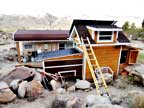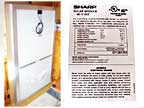Dan Pritchett
to Van
July 23, 11:33 AM |
Van, Tim took me out to your property and we looked at your system. Nice job on the installation!
The Outback MX 60 charge controller is one of my favorites. In the MX 60 menu, under "LOG" I scrolled back about a month and found that the power production from your array averages about 5KWH/day. The last few days have been cloudy and smoky so I saw about 1 to 3 KWH/day. The battery looks like about 20 KWH. I measured the voltage on the individual batteries and found 2 of them at 10.6 volts, the rest were at around 12 volts. This is an indication of regular intervals of low battery charge.
I do not have a good measure of all the loads at your place, but I'm guessing fridge, computers, security, pumps, etc. come to 3KWH/day or more in energy. Based on the voltage spread (about 2 volts) of the batteries, I believe they are not getting a full charge often enough to be happy. They need to come to float at least three times a week. (absorb @ 57.6 volts for 3 hours, float @ 54.4 volts)
I usually try to design the battery size to solar array size ratio at 10h to 1 - a 20 KWH battery needs a 2 KW solar array. Your array looks like about 1 KW.? My opinion is that you need to double the size of your solar array.
It looks like your solar array is 2 series strings of 2 panels at 60 volts each joined at the Midnite Solar combiner with 2 breakers. If you rearrange your array so that you make a single series string of 4 panels, this would give 120 volts at one breaker in the combiner freeing up the other breaker for a new, identical array nearby. A ground mount is simple, or the shade structure [carport] could be used for a mount.
Great to see your place, I hope this is useful info for you. Sincerely, Dan Pritchett 951 805 8801
|
Van to Dan
6:27 PM |
Dan, Thanks for the compliment. Lately I have been having serious doubts about the "Nice job" part.
Okay, so I can assume that the MX60 is not malfunctioning. However, I do want to look into one that would allow me to read and tweak the settings on my computer (and one that hopefully does not have recessed bolts that cannot be removed with vice-grips when they freeze up).
I am thinking about getting a generator, such as the "Generac EcoGen Series 5818- 6kW Standby Generator for Off Grid Applications (LP)", to tie into the system, but that may be awhile and I need this fixed now. However, from what you say, I suspect that the generator would be running on a daily basis.
 As to where you might but them, I suppose the 2.5" square steel framing of the carport would hold the weight during the occasional gale-force wind gusts, but I would probably prefer that they be on a ground mount, as you indicate, on the slope behind the existing panels.
As to where you might but them, I suppose the 2.5" square steel framing of the carport would hold the weight during the occasional gale-force wind gusts, but I would probably prefer that they be on a ground mount, as you indicate, on the slope behind the existing panels.
There is a reasonably level area there where you would not have to deal with boulders, and that would minimize the cable reach, as long as the mount can be high enough to avoid the winter shadow from the utility house and existing panels.
Can you give me a quote? Thanks, Van
|
Peter Saflund
to Van
July 28, 4:38 PM
copied from message board:
[Comments box at bottom of screen] |
Van - followed your blog since I too am a part-time desert dweller in a trailer and entirely off-grid. I saw your newly added thread with Backwoods and MK. I'm an electrical engineer but much enjoy working with my hands and installed a multi-panel system with a 2KW Magnum Energy inverter (the last of several systems working up to this). I also worked in commercial telecommunications including Mt. Top sites.
I noticed immediately some things you might consider.
You do not have a system monitor such as Bogart Engineering (available from Backwoods) or as an optional accessory for an inverter charger system such as from Magnum Energy. Without one you cannot accurately track your actual battery state of charge. The Outback MX 60 and Mate work for the charge controller only.
It seems both Backwoods and MK failed to advise that with four strings of batteries, the maximum available current from your charge controller divides by four. Thus, if you have, say, 24 amps at MPPT from the MX 60, each string is charging at only 6 amps, so parallel strings of batteries are inadvisable. Better to have bigger batteries, because bulk charging requires a large enough constant current to 'stir up' the electrolyte (this is true of AGM and Gel batteries as well) and without this current the battery may sulfate.
With 4 strings and the relatively small array on your roof you may never fully charge 4 strings. Fewer strings would actually be better.
Equalizing is a partial solution - but equalizing has limited effectiveness with AGM since there is no actual liquid electrolyte to 'boil' as in a flooded lead-acid.
Also, consider the 'charge efficiency' of the battery system which is partly a function of the battery chemistry (AGM is less efficient than flooded) AND the battery temperature. The charge controller's temperature sensor is reducing the charging voltage if it's hot, to a lower programmed set point.
In the middle of the Central Washington desert (it can get to 110F), max charge voltage is 1.2V - 1.6V (24V system - double for your 48V system) lower than 'normal', and lower panel efficiency reduces the available power as well.
In winter, shorter days reduce charging time even with full power from the array. Remember, all the usual ratings for batteries are under STC (standard test conditions (usually spec'd between 68 -75 degrees F). Charge efficiency and max charging voltage decline from STC upward.
My system is 750 Watt solar with a Midnight Classic MPPT Charge Controller and a Magnum Energy 2KW Sine Wave Inverter with a battery monitor. It powers a deep well pump, fridge, power tools, lights, TV, coffee maker, washer, computer, satellite internet and web cams. 2 Strings x 4 L-16RE Trojan 6V Batteries. I max is 28 - 31 Amps which is about 14 Amp per string. Typical daily discharge is 15 - 25%. Latitude 48 north.
|
Van to Pete
July 29, 2:07 AM |
Pete, This is fantastic. Thank you.
What do you mean by "I max is 28 - 31 Amps ..."?
Dan Pritchet has suggested almost exactly what you have said, except that you have given it a little more meat; something for me to chew on.
In my reply to his evaluation, I said "I do want to ... read and tweak the settings on my computer". With the Bogart Engineering PentaMetric monitor and software that you suggested, I should be able to do that, though I still need to study their web site more thoroughly to confirm that it will work with my configuration, or if I will first need to upgrade my controller and/or inverter.
You are right that I did not know that going from 3 strings to 4 would reduce the amperage going to the batteries. And it makes sense. In all fairness somebody along the line very well could have told me that. Due to the way my head works, if it was said to me over the phone, I probably would not have retained it. In writing I can read and reread until I do get it, even if it is a year or two down the line of multiple assimilations feeding into each other until it suddenly makes sense - and as new information such as yours clarifies the situation.
|
Pete to Van
July 30, 1:05 PM |
'Imax' is the maximum solar array current available from the output of my MPPT controller. "I" is the symbol for current or amperage in electronics.
The controller is spec'd at 60 Amps capacity but I'm about out of room to add additional panels without extending the roof of the powerhouse.
At some point you may want to consider replaceing your Exceltech inverter with an Outback inverter/charger (since you already have the MX 60 and Mate). Every few days you could run your generator for 3-4 hours and 'top up' the batteries while you are there.
It looks like you're getting some knowledgeable help. I wish I had your carpentry skills.
|
| Pete's setup: |
Hi Van, I've shared a folder with some photos of my system. Pete {years later: unshared)
|
Dan Pritchett
to Van
July 31, 1:59 PM
(10:59 PST) |
Hi Van, I'll be out near your place later today. I need to find out the specs on your installed panels so I can match them electrically.
If you have that info, please send it over to me, if not I would like to climb up there and read the specs off of the back of the panels. Dan
|
Van to Dan
4:08 PM
1:08 PST |

| SOLAR MODULE |
| PHOTOVOLTAIC MODULE |
| ND-216U2 |
| E160673 |
| THE ELECTRICAL CHARACTERISTICS ARE WITHIN +/- 10 PERCENT OF THE INDICATED VALUES OF Isc, Voc, AND +10/-5 PERCENT OF Pmax UNDER STANDARD TEST CONDITIONS (IRRADIANCE OF 1000W/m², AM 1.5 SPECTRUM AND CELL TEMPERATURE OF 25°C) |
| Maximum Power | (Pmax) | 216.0 | W |
| Open-Circuit Voltage | (Voc) | 36.3 | V |
| Short-Circuit Current | (Isc) | 8.35 | A |
| Rated Voltage | (Vpmax) | 28.7 | V |
| Rated Current | (Ipmax) | 7.53 | A |
| Maximum System Voltage |
| 600 | V |
| Maximum Series Fuse |
| 15 | A |
| Field Wiring |
| Copper Only 14 AWG Min.
Insulated For 90°C Min. |
SHARP ELECTRONICS CORPORATION
SOLAR SYSTEMS DIVISION
5901 BOLSA AVENUE, HUNTINGTON BEACH, California 92647
MADE IN MEMPHIS • TN FROM DOMESTIC & IMPORTED PARTS |
|
Dan to Van
6:11 PM |
Perfect. I'll get a quote together for a ground mount just behind the shop at the base of the hill.
|
|